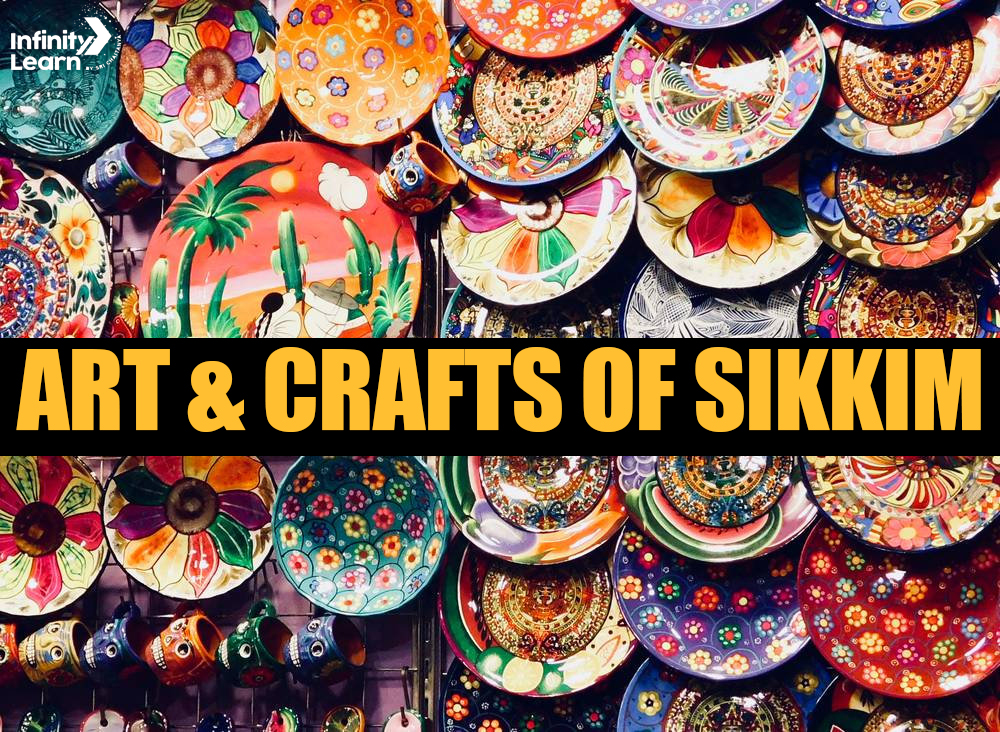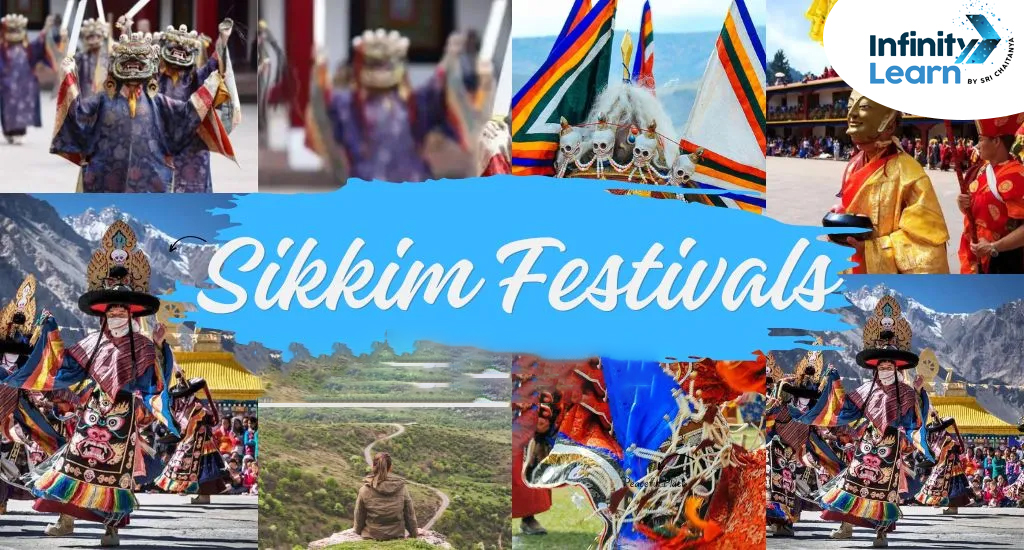Table of Contents
Sikkim, an Indian state, is celebrated for its rich and diverse culture. Folk culture of Sikkim is a mix of different traditions, religions, customs, and languages from various communities. The people of Sikkim are known for their warmth, friendliness, and natural hospitality.
Cultural heritage of Sikkim is a fascinating blend of different customs and religions practiced by its residents. It’s a beautiful place where various tribes and races peacefully coexist. Each of these diverse groups has its own unique characteristics, including special festivals, languages, customs, and crafts. You can see this diversity in the ethnic groups, religions, and languages found all across Sikkim. The state is also famous for its lively festivals, delicious food, captivating music, and vibrant dances, all of which are integral parts of culture of Sikkim.
History of Sikkim Culture
The culture of Sikkim has a rich history influenced by different tribes and traditions. It used to be an independent kingdom in the eastern Himalayas, then became part of India. The local Lepcha people and Tibetan settlers have played a big role in shaping Sikkim culture.
Sikkim culture is a mix of Tibetan and tribal influences, with beliefs from before Buddhism. The Namgyal dynasty started the Kingdom of Sikkim in the 17th century, and it was ruled by Buddhist priest-kings called the Chogyal.
Sikkim culture has traditions, folk dances, and customs that make it a colorful and unique part of India’s cultural scene.
Art & Crafts Of Sikkim
Skkim is famous for its diverse culture, and this is reflected in its unique art and crafts. Some of the main art and craft forms in Sikkim include:
- Thangka Paintings: These are special paintings in Sikkim that show images related to Buddhism. They were originally made by monks and priests but are now produced commercially to support monasteries and practitioners.
- Wood Carvings: Sikkim is known for its beautiful wood carvings found in monasteries, temples, and religious places. These carvings often depict symbols and icons from Buddhism, and masks used in performances are also intricately carved from wood.
- Carpet Weaving: Sikkim has a tradition of weaving carpets by hand. These carpets have artistic designs and are dyed using traditional vegetable dyes. They are durable and comfortable, making them highly valued.
- Handlooms: Handloom products from Sikkim, like shawls with traditional designs such as dragons, prayer wheels, and natural scenes, are popular among tourists for their style and warmth.
- Bamboo and Cane Crafts: Sikkim also has a tradition of making crafts from bamboo and cane. These are unique to the region and showcase the skills of local artisans.
- Metal Work: Sikkim is known for its metalwork, which includes creating traditional items and decorative pieces.

The Government of Sikkim is working to preserve and promote art and culture of Sikkim through initiatives like the Handicraft and Handloom Institute. These artistic creations not only bring pride to Sikkim’s culture but also boost tourism by attracting visitors from both India and other countries.
| Culture of Manipur | Culture of Bihar |
| Culture of Assam | Culture of Andaman and Nicobar Islands |
| Culture of Rajasthan | Culture of Odisha |
| Culture of Kerala | Culture of Telangana |
Food Culture of Sikkim
Sikkim’s food culture is a mix of Tibetan, Nepali, and Lepcha dishes from different ethnic groups. The main food is rice, and they also eat a lot of fermented foods. They use lentils, fresh vegetables, bamboo shoots, wild flowers, mushrooms, and nettle leaves. For non-vegetarians, they enjoy beef, pork, and fish.
Sikkim is known for being organic, and they use grains like rice and millet, as well as fruits, in their dishes, making their cuisine special.
Some popular Sikkimese dishes are momos, thukpa, phagshapa, sha phaley, gundruk, sinki, and chang.
Music & Dances of Sikkim
Sikkim is famous for its vibrant music and dance customs, especially the monastic dances. The most well-known dances are the mask dances, called ‘Chaams,’ performed during festivals and special occasions. These dances are thought to chase away evil spirits and demons.
The Chaams dance begins with the sounds of gongs, ceremonial drums, and cymbals, creating a magical atmosphere. It’s performed by Buddhist monks, accompanied by various rhythms and traditional musical instruments. Sikkim’s music and dances are a crucial part of its cultural heritage, reflecting the state’s unique traditions and beliefs.
Traditional Dress of Sikkim
The cultural dress of Sikkim, especially for the Bhutia people, is called “Kho.” It’s a loose, cloak-style garment that’s tied at the neck on one side and around the waist with a silk or similar belt. Women wear a silk, full-sleeve blouse called “honju” under the Kho and a loose gown-like garment tied near the waist with a belt. Both men and women wear the Kho, which is quite similar to the Tibetan Chuba, but it doesn’t have sleeves.
In addition to the Kho, people in Sikkim also wear other traditional outfits like the “Bakhu,” which is another loose cloak-like clothing tied at the neck and cinched at the waist with a silk or similar belt. Nowadays, women often pair the Bakhu with jeans to give it a more modern touch.

Bhutia women adorn themselves with various types of jewelry, including earrings (“Yencho”), necklaces (“Khao”), pearl ornaments (“Phiru”), gold bangles (“Diu”), thick silver-coated anklets (“Khalli”), and rings (“Joko”). They have a preference for pure 24-carat gold jewelry.
During weddings, the bride typically wears traditional attire, which includes a piece of cloth called “Hembari” elegantly wrapped around the upper body. They also use a shawl known as “Majetro.” Additionally, Nepalese women wear a colorful piece of cloth from their head to waist while dancing, called “Pachauri.”
Festivals of Sikkim
Sikkim, a state in northeastern India, is famous for its cultural festival of Sikkim. The culture of Sikkim is showcased through various festivals celebrated throughout the year. Some of the important festivals in Sikkim are:
- Losar: This is the Tibetan New Year festival, celebrated with joy and traditional customs.
- Saga Dawa: A significant Buddhist festival that honors the life of Lord Buddha.
- Losoong: It marks the end of the harvest season and features traditional dances, music, and religious ceremonies.
- Bumchu: A renowned festival in West Sikkim, where Lamas at the Tashiding monastery open a sacred water-filled pot.
- Phang Lhabsol: A unique festival that pays tribute to Mount Kanchendzonga, the guardian deity of Sikkim.
- Indra Jatra or Yenya: The largest festival for the Nepalese Newar community, celebrated with enthusiasm.
- Maghe Sankranti: A significant festival heralding warmer days, celebrated for three days in mid-January.
- Durga Puja (Dassain): The main festival of the Hindu Nepalese in Sikkim, celebrated in September-October.
- Sonam Lochar: Marks the start of the Tibetan New Year, widely celebrated among the Tamang community.
- Drupka Teshi: A festival commemorating the first sermon of Lord Buddha.

These festivals include colorful cultural performances, traditional rituals, and a showcase of Sikkim’s unique heritage, making them an essential part of Sikkim’s cultural identity.
Languages of Sikkim
Sikkim, a state in northeastern India, is home to people who speak different languages. The official languages in Sikkim are English, Nepali, Sikkimese (Bhutia), and Lepcha. Apart from these, there are various other local languages spoken by different groups in the region.
Here are some of the main languages of Sikkim:
- Nepali: Most people in Sikkim speak Nepali because a large part of the population is Nepalese.
- Sikkimese (Bhutia): The Bhutia community, originally from Tibet, uses this language.
- Lepcha: The Lepchas, the original inhabitants of Sikkim, have their own language, but it’s not widely used.
- Gurung: The Gurung people speak this language in two dialects and use the Devanagari script.
- Dzongkha: This language is related to Sikkimese and is mostly spoken in Bhutan and the northern border regions of Sikkim.
- Groma: Another Tibetan language with some speakers in Sikkim.
- Hindi: Hindi, India’s official language, is also spoken in some parts of Sikkim.
- Tibetan: Some people in Sikkim speak Tibetan.
- Yakha: The Yakha community in Sikkim uses this language.
English is commonly used in Sikkim, especially for official purposes and in schools. The state’s variety of languages reflects its rich cultural heritage and the peaceful coexistence of different communities.
Interesting Facts About Culture of Sikkim
Here are the interesting facts about culture of Sikkim:
- Buddhist Influence: Sikkim’s culture is strongly shaped by Buddhism, which can be seen in its many monasteries, stupas, and the celebration of Buddhist festivals like Losar, Saga Dawa, and Lhabab Duechen.
- Diverse Ethnic Groups: Sikkim is home to various ethnic groups, such as the Bhutias, Lepchas, and Nepalis, all adding their own special elements to the cultural mix of Sikkim.
- Masked Dances: Monastic dances with intricate masks and costumes are a significant part of Sikkim’s cultural festivals, representing various aspects of Buddhism.
- Pang Lhabsol Festival: This festival, unique to Sikkim, honors Mount Kanchenjunga, the world’s third-highest mountain, seen as a guardian deity of the state.
- Thangka Art: Thangka painting, a type of Tibetan Buddhist art, is popular in Sikkim. These paintings have symbols and are used for meditation and teaching.
- Handicrafts and Handlooms: Sikkim is famous for its handicrafts and handwoven items, like carpets, woodwork, and the traditional Lepcha weave, a significant part of its culture.
- Cultural Homestays: Sikkim encourages cultural homestays, offering visitors a chance to experience the local way of life, customs, and traditions, preserving and sharing its rich cultural heritage.
FAQs on Culture of Sikkim
What is the art culture of Sikkim?
The art culture of Sikkim is known for its beautiful Thangka paintings, intricate handicrafts, and wood carvings. These arts reflect Buddhist themes and the state's rich cultural heritage.
What is the cultural dance of Sikkim?
Sikkim's cultural dance includes traditional forms like the Chaam, performed by monks in monasteries, and folk dances like Lu Khangthamo and Rechungma, showcasing the state's diverse ethnic heritage.
What is the cultural festival of Sikkim?
Losar, the Tibetan New Year, is a major cultural festival in Sikkim. Celebrated with traditional music, dance, and rituals, it symbolizes the rich Buddhist culture of the region.
What is the religion of Sikkim?
Buddhism is the predominant religion in Sikkim, influencing many aspects of its culture. Hinduism and other indigenous faiths are also practiced, reflecting the state's religious diversity.
What is the society and culture of Sikkim?
Sikkim's society and culture are a harmonious blend of various ethnic groups like the Bhutias, Lepchas, and Nepalis, each contributing their unique customs, languages, and traditions.









